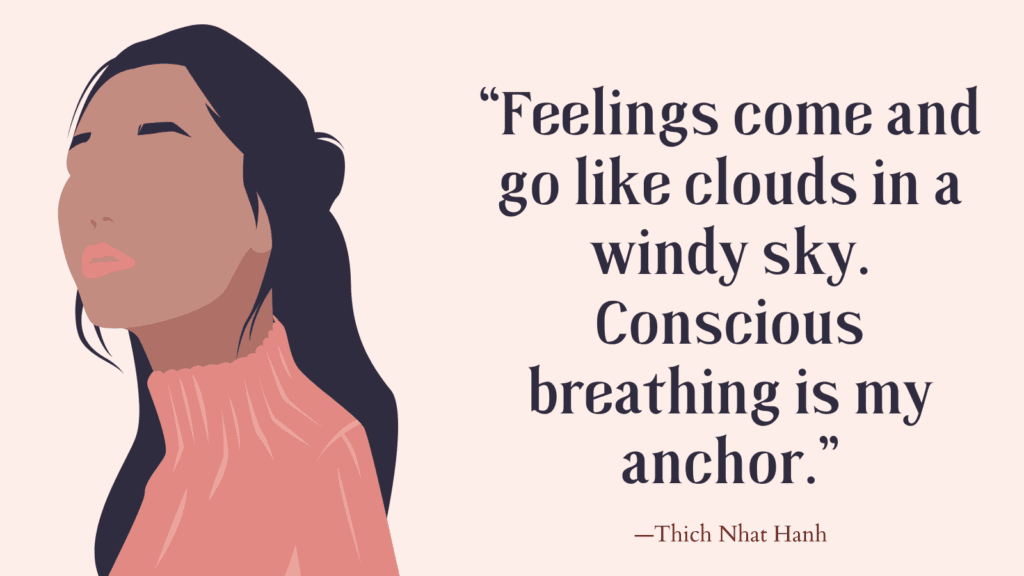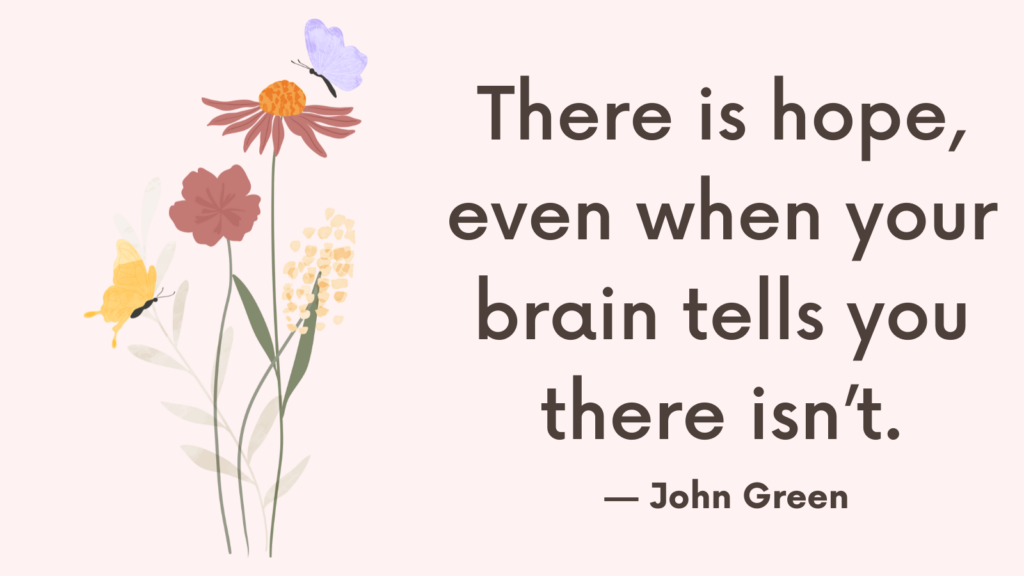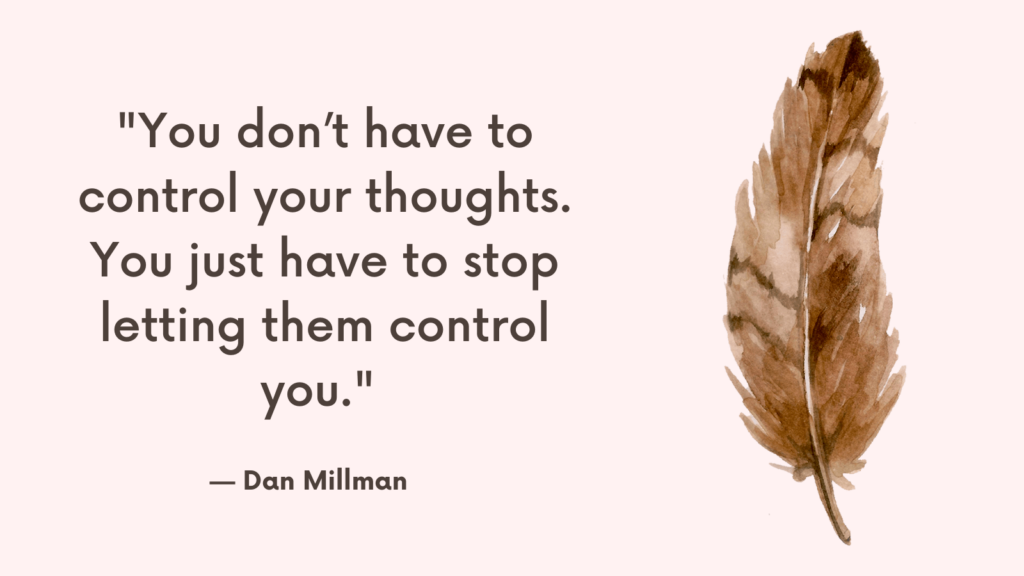In this post, you’re going to discover the best mindfulness exercises for adults that will help you manage your emotions more effectively.
What Is Mindfulness?
Mindfulness is simply the practice of focusing your attention rather than letting your mind wander. (*)
You can practice mindfulness any time and in any place.
For example, you can focus all of your attention on any daily activity, such as showering, or even washing the dishes, being fully present in each moment, feeling the sensations, hearing the sounds, and seeing the sights.
This sounds simple but our minds’ tendency to wander and ruminate can make the practice very difficult at first.
When practicing mindfulness, you experience thoughts and emotions as an observer watching them as they pass, rather than being carried away by them.
How Could I Genuinely Welcome My Difficult Emotions?
The goal of practicing mindfulness is to not only be present with your difficult emotions but also to actually welcome them.
This might sound counterintuitive, but you probably have learned by now that the more you fight these difficult emotions, the more intense they become and the more they persist.
Welcoming your difficult emotions doesn’t mean that you’re inviting them in your life or that you want them to remain. Your difficult emotions already exist whether you welcome it or not.
The more you allow your difficult emotions to be present, the less control they’ll have on you and the more likely they are to fade away.
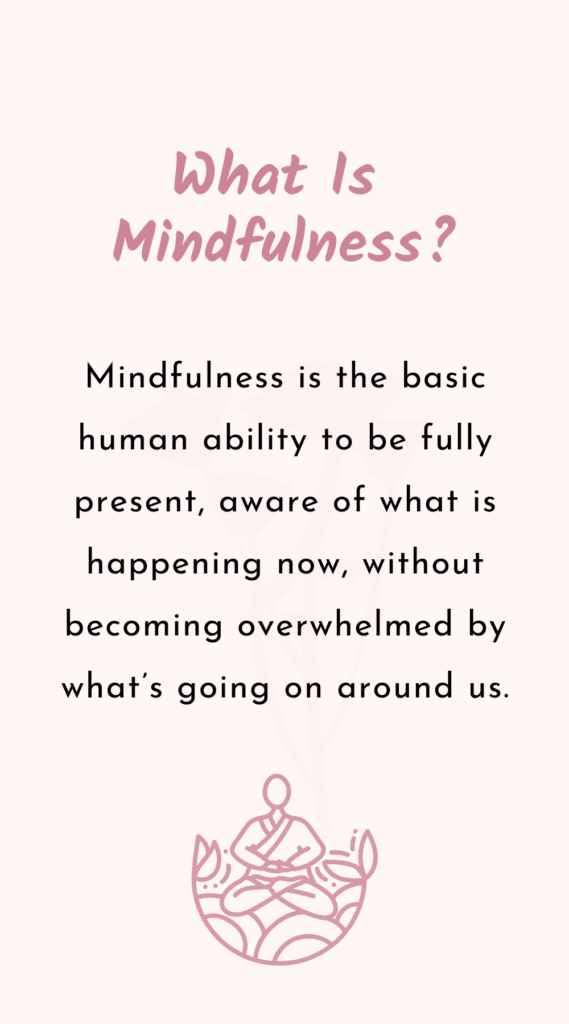
Self-Compassion
Having compassion for yourself means being aware of your own suffering and having a desire to relieve that suffering and feel better.
What does it mean to be aware of your own suffering?
You might be thinking, “I am already too focused on my unhappiness.” But the truth is, most of us have a vague sense that we are unhappy.
We avoid thinking much about the details or the reason behind our unhappiness.
Mindfulness helps you learn how to be fully aware of and present with reality— just as it is—including your own suffering.
Why do you need to be aware of your own suffering?
You can’t change something that you don’t understand.
That’s why becoming aware of your own suffering and the reason behind it is an essential step on the path toward feeling better.
The desire to relieve your own suffering
Although no one wants to suffer, many people strongly believe they can’t feel better or that they don’t deserve to feel better.
Self-compassion helps you recognize that these thoughts are just thoughts, not facts and that no matter what your thoughts may be, you can feel better.
8 Mindfulness Exercises For Adults For Emotion Regulation
#1. Daily Meditation Practice
Mindfulness is about focusing your attention on the present moment. You try as best as you can to keep your awareness on the sights, sounds, and physical sensations that are occurring in this very moment.
Mindfulness is about the compassionate acceptance of whatever you experience in the present moment.
Acceptance doesn’t mean that you have to like what you’re experiencing or that you want it to remain.
Acceptance doesn’t mean being passive. It’s the opposite.
It’s only when you are aware of what’s going on that you can see the best course of action.
In fact, it’s when you try to push away difficult emotions and negative thoughts that they intensify.
Practicing Regularly
Mindfulness practice helps rewire the brain and makes it easier for you to keep your attention focused on the present moment.
Mindfulness is a skill you need to learn and the more you practice, the more skillful you become.
1. Planning Your Practice
To start with mindfulness, choose a certain time of day to practice regularly.
You can experiment until you find the time that works best for you.
2. Where to Meditate
How quiet does your sitting space need to be?
It doesn’t have to be absolutely quiet.
Many people enjoy practicing mindfulness outdoors, surrounded by all kinds of nature noises. Some find these sounds to be soothing.
You might find noise distracting, but with time, you can learn to be mindful no matter where you are.
3. How Long to Practice
You want to start small but it’s important to have a specific duration for each practice.
Start with five- to ten-minute range and then add to that based upon how it goes.
You can use your smartphone app but keep the device out of sight, so you won’t be tempted to peek at it.
4. Sitting Posture
It is perfectly fine to practice mindfulness sitting on a chair.
Many people choose to sit in Burmese position on cushions on the floor with your legs crossed and your hands on your lap, as the following illustration shows:
5. Focusing on the Breath
The breath serves as an anchor for your attention.
Focusing on the physical sensations of the breath, help your attention become fixated on the present moment.
Apps like The Mindfulness App, Headspace, Calm, and buddhify can help introduce you to mindfulness and silent meditations.
Mindfulness Practice
1. Get in a comfortable position where you won’t be disturbed and set your timer for five minutes.
2. Close your eyes or loosely focus on the floor and take a moment to relax the muscles throughout your body.
3. Bring your attention to the physical sensations of your breath. Notice the air coming into and out of your nose, the rising and falling of your chest, and the expanding and contracting of your abdomen. You don’t have to change your breath, just notice it.
4. If you find it difficult to focus on the physical sensations of your breath, try counting each inhalation and exhalation cycle of your breath.
5. If you find your mind wandering, acknowledge that and gently bring back your focus to your breath.
6. When the timer goes off, bring your attention back to your sitting space and congratulate yourself!
Related: 15 Easy Mindfulness Activities to Help You Deal With Anxiety, Depression, and Trauma
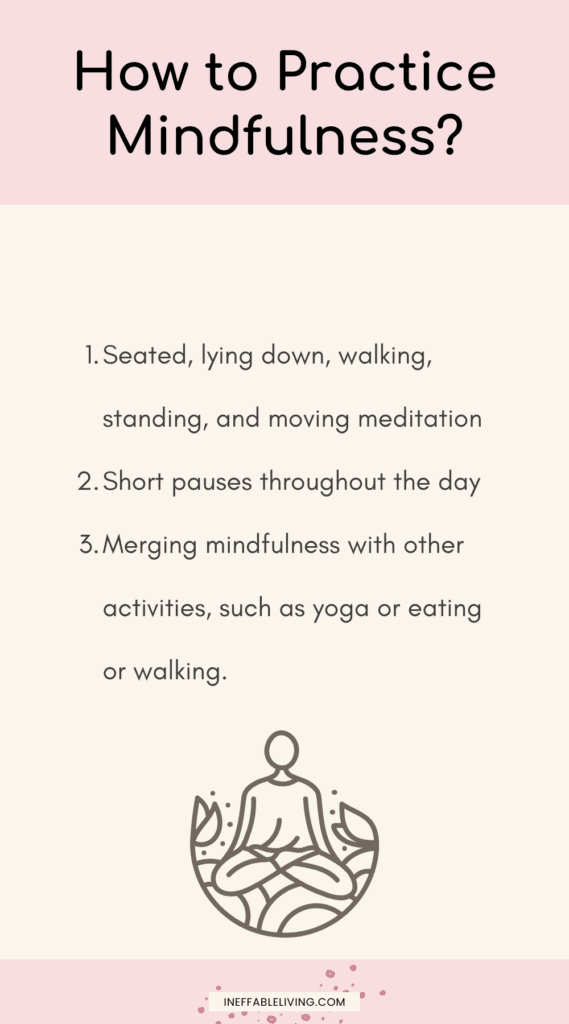
#2. Mindfulness Exercise For Depression
Automatic negative thinking patterns can bring on or worsen depression. Depression can also bring on negative thoughts, creating a vicious cycle with each making the other worse.
Mindful awareness of the present moment can help you move out of this negative thinking pattern.
How to move out of your negative thinking pattern?
Practicing mindfulness helps you become aware of your negative thoughts and allow them to fade away quickly.
You’ll also discover that creating distance between your distressing thoughts and yourself, will help you think clearer and take positive action to feel better.
Such activities may include:
- Listening to uplifting music
- Watching a funny video
- Exercising
- Spending time outdoors
- Painting
- Reading your favorite book
- Dancing
- Doing volunteer service
- Gardening
- Etc.
LIST OF PLEASURABLE ACTIVITIES
Mindfulness Practice
1. Sit in a comfortable position. Close your eyes and take a moment to relax your body.
2. Begin to focus on your breath and the physical sensations of your breath.
3. Once you feel anchored in the present moment, notice what automatic thoughts are running in your head and what emotions can you feel.
Some of these thoughts may include “I’m worrying about how long I will be depressed,” or “What can I do to get out of this depression.”
4. Acknowledge the thoughts and emotions you’re experiencing without judging them as right or wrong, and without trying to fix or change anything. Allow yourself to stay present with it.
After this practice, you may notice that your thinking is clearer, now that you created a space between your thoughts and yourself.
You may be able to see that there are some actions that you can take to feel better. You may also realize that you don’t have to do anything.
#3. Mindfulness Exercise For Anxiety
Anxiety, like every other emotion, serves a purpose.
It alerts us to potential threats, allowing us to evaluate and respond to them in effective ways.
But when anxiety becomes excessive or greater than the situation deserves, it becomes malfunctioning.
The mind’s automatic thinking response to anxiety almost always makes it worse.
When you mindfully sit down with anxiety, you allow it to fade away.
Mindfulness may seem illogical and counterintuitive to you. After all, we don’t want to feel emotional or physical pain. However, avoiding your emotions often backfires.
Being Comfortable with Not Knowing
One of the main reasons why we feel anxious is the fear of uncertainty.
Not knowing what is going to happen, often makes us fear the worst. It’s our mind’s way to fill in what we don’t know – this is a survival mechanism to help us prepare for various scenarios.
While this way of thinking can be helpful in making effective decisions, more often it takes the form of worry, with our minds going round in circles.
This is where mindfulness comes. By being present with your thoughts and emotions, you can become aware of and correct cognitive distortion, shift perspective, and see relax with not knowing.
Mindfulness Exercise
1. Start by thinking of something that brings on a degree of anxiety that isn’t overwhelming.
2. Sit in a comfortable position with your eyes close or loosely focus on the floor and take a moment to relax the muscles throughout your body.
3. Bring the anxiety-provoking situation into your awareness. Keep some of your attention on your breath to stay anchored in the present moment.
4. Notice everything that happens in your mind and in your body as you hold the anxiety-provoking situation in your awareness. The goal here is to become curious.
What emotion arises in your body? What thoughts do you have? What happens over time? Does the situation stay sharp in your awareness, or does it get fuzzy?
Remember that you don’t have to change or fix anything. If you notice yourself getting carried away with your automatic thoughts, gently bring your attention back to the breath and to the present moment.
5. End your practice by focusing your attention on the breath for a minute or two.
Sometimes anxiety will fade quickly, and other times it may persist. The goal is to become aware of your automatic thinking patterns and notice any distortions in it. Mindfulness can also help you realize that the emotions associated with your fear are not that hard to tolerate and that they seem to wither away when you invite the feared situation to be present.
Anxiety Worksheets
#4. Mindfulness Exercise For Observing Your Thinking Patterns
Negative thinking patterns can increase depression and anxiety
When you practice mindfulness, you can be present with your thoughts, watching them as they come and go like clouds in the sky.
Mindfulness also helps you become aware of cognitive distortions and irrational beliefs, allowing you to replace them with more reasonable ones.
How does automatic thinking play a role in increasing painful emotions?
It usually starts with a physical sensation, such as feeling “sick in the pit of your stomach.”
The discomfort feelings of depression, for example, can cause ruminating thoughts about yourself, such as “I hate this feeling? Why am I feeling this way? What should I do? How long will this last?”
This automatic response can help you take action and feel better. But oftentimes, this thinking pattern becomes negative creating a vicious circle, making painful emotions worse: “Why is this happening to me? Why do I always have to feel this way?”
Checking In with Yourself
Experiencing unpleasant emotions, such as depression, sadness, anxiety, or anger is often accompanied by automatic negative thoughts.
Using mindfulness, you can become more aware of the scripts running in your head. You may find it helpful to keep a journal in which to write these scripts down.
The goal here is to find out which autopilot thinking patterns are helpful and which ones aren’t.
Oftentimes, our thinking is biased. We tend to see life from our own unique viewpoint, which may not be consistent with reality.
Seeing Thoughts as Just Thoughts
Knowing that your thoughts don’t always reflect reality, you can now begin to take your thinking patterns less seriously.
You can now develop a different relationship with your thoughts – a relationship in which you see your thoughts as just thoughts, without labeling them as either good or bad.
Thoughts provide a mechanism to think about who we are, but we are not our thoughts.
Mindfulness Practice
1. Focus on the present moment by anchoring your concentration on the breath for about two minutes. Don’t try to suppress any thoughts you might have, simply let them freely in the background as you gently bring your focus back to your breath.
2. Expand your awareness to include the physical sensations of your body and the sounds around you as they arise and pass.
3. Observe your thoughts. Imagine yourself laying on the grass and looking up at the sky with clouds floating by. Imagine each thought you have placed on a cloud and watch it as it floats.
Just as the clouds aren’t disturbing the sky, observing your thoughts as they arise and pass doesn’t disturb your mind.
Related: 10 Powerful Techniques To Control Your Negative Thoughts
#5. Mindfulness Exercise For Impulsive Behavior
Impulsivity can lead to out-of-character behaviors, such as substance use, excessive shopping, sexual promiscuity, and even suicidal behavior.
Using mindfulness to be present with impulsivity, you can learn how to watch these feelings as they come and go, rather than acting on them.
Impulsivity and Discontent
Our minds always want things to be different from reality. We either want something that we don’t have or want to get rid of something that we currently have.
Satisfying an urge may lead to a short-term experience of pleasure, but it will never bring us true joy, because the mind will become dissatisfied and seek something else.
Mindfulness helps you learn that the mind is never satisfied for long.
Being aware of this can help you let the sense of dissatisfaction run in the background without responding to it and, but also be able to find happiness in the present moment.
Mindfulness Practice
1. Start by thinking of something that causes that brings up some urge but isn’t overwhelming.
2. Focus on your breath. Then expand your awareness to include all of the physical sensations in your body.
3. Now, bring the urge-provoking situation into your awareness. Try to keep your attention on the situation for about three minutes.
4. Notice what thoughts are running through your head? Is there a thought about how good it would feel to act on the urge? Is there any response in your body? Try to notice that without judgment.
5. Finish the exercise by focusing all of your attention on the breath for a minute or two.
#6. Mindfulness Exercise For Irritability And Anger
Your Anger Does Not Define You
Because we tend to experience our emotions intensely, we tend to feel that they define who we are, to some degree.
For example, someone who’s struggling with anger might think of himself as “an angry person.” This can add so much distress.
Mindfulness helps you learn that we are not our emotions. By creating a space between you and your emotions, you begin to see their transient and insubstantial nature.
You can develop a new relationship with anger.
You can start to think of anger as a useful emotion in your life. Anger motivates you to take action and correct injustice. It helps you stand up for yourself and the ones you care about.
Mindfulness Practice
1. Start by thinking of an anger-provoking situation. Choose one that brings up some annoyance or frustration but that doesn’t bring on intense anger or rage.
2. Focus your attention on your breath then expand your awareness to include all of the physical sensations in your body and the sounds around you.
3. Now bring the anger-provoking situation into your awareness. Keep your attention on the situation for about three minutes, observing any response in your body or thoughts.
4. Allow your thoughts and emotions to arise and pass like clouds in the sky.
5. Bring the exercise to an end by focusing again on your breath for a minute or two.
Related: How To Manage Your Anger In Healthy, Effective Ways?
#7. Mindfulness Exercise For Self-Awareness and Self-Esteem
The Mind Is Never Satisfied With The Self
How you see yourself can profoundly change your life.
The mind is never satisfied for long even when it comes to the self. Examining your thoughts, you may notice critical thoughts of how you looked, doubts about the career you’ve chosen, a vague sense that your life should be different, etc.
Mindfulness helps you realize that your mind is never satisfied. No matter what you do or accomplish, you’d still feel a sense of dissatisfaction with yourself.
While this realization might seem disheartening, it is also liberating.
It’s only when you realize that you’ll never be completely satisfied for long that you can finally let go of the need to feel satisfied, and that you can just be yourself and enjoy each moment fully.
Exploring Your Self
Mindfulness helps you realize that your self-concept is mostly a collection of thoughts and memories that cannot be fully trusted.
Your memories involve key moments that stuck out, with the day-to-day events forgotten.
Furthermore, research suggests that we are more likely to remember negative experiences over positive experiences, and in general, we tend to notice the negative moments more than the positive ones.
Many psychologists believe that it’s more important for survival to notice difficult and dangerous situations than positive ones.
Through mindfulness, you learn that your mind cannot be fully trusted.
Mindfulness Practice
1. Find a comfortable position and start by focusing on your breath. Then expand your awareness to include all of the physical sensations in your body and the sounds around you, your thoughts, and your emotions.
2. Knowing that the mind is never satisfied with the self, what does this say about some of your deeply held beliefs and sense of who you are? Sit down with these questions for a few minutes.
You may find out that you define yourself mostly through key memories and automatic thinking patterns, which is not an accurate way to see yourself.
3. Bring the exercise to an end by focusing your attention on your breath for a minute or two.
#8. Mindfulness Exercise For Experiencing Joy Now
Many people believe that happiness is based upon external circumstances (a new phone, a new car, a vacation, a relationship, a raise at work, etc).
Mindfulness helps you recognize that these circumstances cannot satisfy the mind or make you happy for long.
It also helps you learn how to experience joy and happiness right now—rather than at some point in the future.
Why external situations can’t be the source of our joy?
One reason is a phenomenon known as ‘hedonic adaptation.’
In 1978, a study investigating how winning the lottery or becoming a paraplegic can influence the level of happiness found that one year after the event, both groups were just as happy as they were before the event.
This means that no matter what happens to you, once you’ve adapted to the new event, you’ll revert back to your initial level of happiness.
This isn’t to say that you can’t be happier than you are right now. But external events, such as being single or married, working or jobless, etc., in the long run, have very little impact on your happiness.
In fact, according to Sonja Lyubomirsky, author of The How of Happiness, 50% of our happiness is determined by genetics, 40% by internal factors, and only 10% percent by external factors.
The bottom line is: It’s your attitude towards life that influences your happiness, and not what happens around you.
Mindfulness Practice
1. Find a comfortable position to sit and start by focusing on your breath and then expanding your awareness to your body sensations and sounds around you, thoughts and emotions.
2. Allow happiness and joy to arise. Focus on a positive memory or thought and sit with feeling for about five minutes.
3. Bring the exercise to an end by focusing again on your breath for a minute or two.
By being fully present with each moment, you can discover the beauty of the things we like that are already occurring in our lives.
Related: Overcome Suffering In Your Own Way: 4 Keys To Relieve Suffering
FAQs
Are Meditation And Mindfulness The Same Thing?
Mindfulness is about being present and paying attention to what’s happening around you and inside you (thoughts, feelings, body sensations). Mindfulness can be practiced doing any activity throughout the day,
Meditation, on the other hand, is a distinct activity, practiced for a specific amount of time.
Mindfulness can support and enrich meditation. It’s also a form of meditation, called mindfulness meditation, during which attention to an anchor (like your breath).
How Mindfulness Meditation Changes The Brain?
Brain researcher Richard Davidson asked the Dalai Lama for permission to research eight monks out of His Holiness’s closest circle. (1)
The monks were asked to enter deep relaxation while having their brains scanned by a magnetic resonance imaging (MRI) scanner.
The research found that active meditation changes the structure of the brain. The left frontal lobes of the brain of these monks were much higher than in the control group, comprised of 150 non-Buddhists.
This region of the brain is associated with optimism and good moods, which means that happiness is a skill that can be trained like a muscle.
How to Practice Mindfulness Meditation?
Note: if you suffer from PTSD or trauma symptoms, use trauma-sensitive mindfulness practice so you won’t exacerbate symptoms of traumatic stress.
Read more about trauma-sensitive mindfulness here.
#1. Start Small And Work Your Way Up
Meditate for five to ten minutes every day and then add on time as you get less squirmy.
There are no rules about how to sit, where you have to do it, no set amount of time, or right things to feel. You just need to do it.
It’s like exercising regularly or eating healthy food – you don’t have to do it, and the temptation to give up is big, but if you make it a habit, it will get easier to do and harder to break, but it’ll also improve your entire life.
In fact, meditation helps you:
- Be in the present moment.
- Raise your vibration.
- Open up to receive endless information and ideas.
- Strengthen your intuition and ability to focus for longer periods of time.
- Relax and relieve stress.
- Boost your mood.
#2. Basic Mindfulness Meditation
The following are some simple steps to meditate:
1. Sit up straight in a comfortable, cross-legged position on the floor or in a chair. Put your hands in your lap or on your knees.
2. Relax your face, especially your jaw and forehead.
3. Close your eyes and focus on your breathing. You don’t have to breathe in any special way. Just notice its movement in and out of your body.
4. If any thought comes to your mind, gently, release it and refocus on your breathing.
5. Listen for any intuitive hits that may or may not come through.
That’s it!
Other Options
* Set a timer so you won’t distract yourself by constantly checking the clock to see how long you’ve been at it.
* As an alternative to the breath method, imagine a bright beam of light coming down from the sky, shining through the top or your head and running through your body. This will help you focus and feel deeply connected to Source Energy.
* To help your mind clear from any distracting thought, use a mantra. Repeat words or phrases in your mind such as “love”, or “thank you” whatever makes you feel good and connected to Source Energy.
* Meditation is about receiving information from The Universe. If there’s something in your life that you’re working on or through, meditate with the intention of receiving help.
#3. Guided Meditation
There are many CDs, DVDs, and videos on Youtube to walk you through mediation. This can be especially helpful when you’re first starting out and you’re having trouble focusing and keeping your mind clear of chatter.
It can also be helpful to meditate in groups in guided meditation centers. Do a research for meditation centers in your area.
The important thing is that you do it consistently until it becomes a well-established habit. Eventually, it will start making a notable difference in your life.
FREE Coping Skills Worksheets PDF
References
- The Science of Mindfulness – Mindful
- Harvard researchers study how mindfulness may change the brain in depressed patients – Harvard Gazette
- Effects of Mindfulness on Psychological Health: A Review of Empirical Studies – PMC (nih.gov)
- Research – UCLA Mindful Awareness Research Center – Los Angeles, CA (uclahealth.org)
